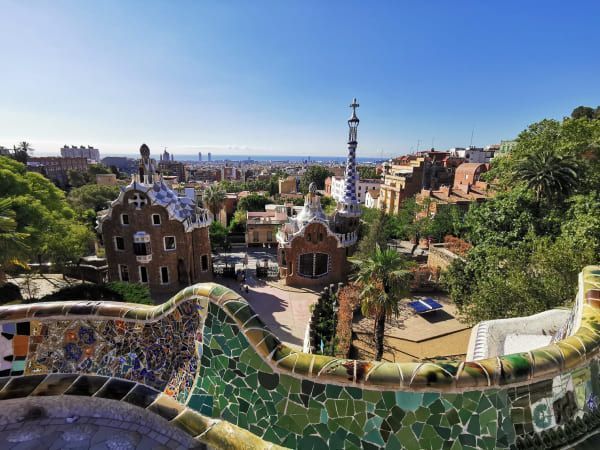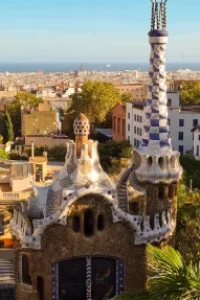

Park Güell Barcelona Tickets

Support when you need it
Customer support to help you with everything you need from 9:00 to 19:00
Fast and online booking
Choose the best option for your needs and preferences and avoid the lines booking here.
#2 Attractions in Barcelona
Enjoy art and nature at Park Güell, an oasis of color and design in the city.
Explore Park Güell, one of Gaudi’s most notable creations in Barcelona. Discover this magnificent green park that is surrounded by a modernist architecture while taking in breathtaking views of Barcelona.
- Enter within 30 minutes of your selected time.
- Don’t miss exploring the Monumental Zone of the park. - The most mesmerizing attraction.
- Stay as long as you want and stroll around at your own pace.
- You can use Bus Turístic (blue line) or Barcelona City Tour (green color) and get off at the stop "Park Güell". It will take 10 minutes to get to the entrance.
Pro Tip: It is better to buy your Park Güell ticket online because entries are limited. It often happens that on busy days, people come directly to the ticket office at noon and cannot visit the park before 7 p.m. in the evening because of the full schedules… So remember to book your ticket online and you will be sure to be able to visit Park Güell at the time of your choice.
About the tour
On the colorful stairs, you immediately see Gaudí’s famous lizard. No one really seems to be able to figure out exactly what kind of animal this ‘monster’ is supposed to represent. Is it a huge salamander? An iguana? Or a lizard, snake head, or dragon? In any case, together with the mosaic bench, this is the most popular photo opportunity in the entire Gaudí park Barcelona!
At the top of the stairs, you arrive at the Sala Hipostila, or the Hall of the 100 Pillars. These Doric columns – 6 meters long and 1.20 meters in diameter – serve to support the platform above, but are also designed to drain rainwater. There are pipes in the columns that ensure that the rainwater from the terrain above is drained to a reservoir that was to supply the garden city with water. The colorful ceilings of the Sala Hipostila are the work of the architect Josep María Jujol, Gaudí’s most creative collaborator.
There are two pavilions, one on either side of the main door. The Casa del Guarda, which is now a part of MUHBA(Barcelona History Museum), was the porter’s home, while the one on the right served as the concierge’s office with a waiting area and a phone booth.
The terrain on which the now so green Park Güell was built was once barren and very dry. Gaudí deliberately chose Mediterranean tree and plant species that would adapt well to the terrain: pine trees, eucalyptus, magnolia, palms, cypresses, almond trees, plums, mimosa, thyme, lavender, sage, and rosemary. Result: it always smells delicious!
You will also find the beautiful Gardens of Austria (Jardins d’Àustria), so named because many trees from Austria were planted here, which Barcelona received as a donation in 1977. The garden was created after the park opened as a municipal park and a nursery was built here.
One of the houses in Park Güell belonged to Eusebi Güell: Casa Larrard. This villa dates back to the eighteenth century but was completely renovated by Gaudí. Today this house is the Park Güell Escola Baldiri Reixac and children go to school here.
On the east side of the square of the Greek Theater, there is an original iron gate with a path leading to the gardens of Casa Larrard. This ‘portico’ or promenade way, one level up from the house, is surrounded by a pine forest and is shaped like a large wave on sloping columns, with a double column for support. It is one of the best examples of the organic architecture that Gaudí stood for. The slanting columns may not give the feeling of stability, but they are designed in such a way that they support things firmly.
Casa Museu Gaudí was Gaudí’s official residence from 1906 to 1925, although he showed himself there less and less over the years: he was totally absorbed in the construction of the Sagrada Família, where he also had a bed from 1925 stand. It is one of two houses that were eventually completed in the garden city of Park Güell, recognizable by its donut-pink outer walls. The house is also called the ‘Torre rosa’ (pink tower).
The second house that did get off the ground in Park Güell was Casa Trias, named after the lawyer Martin Trias I Domenech, the first buyer of a plot in the garden city in 1902. This lovely villa is not open to the public.
The highest point of Park Güell – and according to many the place with the best view of Barcelona – is the hill Turo de les Tres Creus. Here are three crosses on top of a pile of stones, the Golgotha. Two of them indicate the cardinal points (NSEW), and the other points to the sky.
Gaudí had planned to build a chapel on this spot so that the inhabitants of the garden city would have a place to pray. However, during the work, the remains of prehistoric caves came to light and it was then decided to make a memorial site with the three crosses ( tres creus ) here.
What is included
- Access to the Monumental Zone
- Visit at your desired time
- Instant Confirmation
- E-ticket
- Valid for 1 day
- Wheelchair accessible
Advantage: There is no time limit! Once you get in, you can stay
as long as you desire, there are so many things to do at
Park Güell!
Cancellation Policy:
The ticket is non-refundable. Once purchased, the date
and time cannot be changed.
Note:
Due to limited availability, it is possible that the
time slot chosen for your visit may vary by up to 60
minutes.
Enhance your experience with the Guided Tour

Park Güell Guided Tour
- Entrance to Park Güell
- Guided Tour
- No time limit
- Cancellation option
Park Güell Guided Tour
- Entrance to Park Güell
- Guided Tour
- No time limit
- Cancellation option
Location
Address: 08024 Barcelona, Spain
Closest Landmark: Casa Vicens (1.4 km)
Park Güell is on the
Carmel Hills in Barcelona, located in between the
districts of Gracia and Horta-Guinardo. It is in the
neighborhood of El Carmel, Vallcarca I els Penitents, La
Salut, El Coll, and Can Baro. It is spread across the
two hills of Les Menes and El Carmel. 17 hectares of
green scenery space surrounded by urban regions are all
set to welcome you. It is best explored on foot and with
plenty of time to spare as there are many things to do
in Park Güell.
How to get to the Park Güell
Take the metro to Lesseps station (L3, green metro line) and walk through Plaça Lesseps and the busy Travessera de Dalt to Carrer Larrard. Here you turn left and walk up until you see the main entrance of Park Güell at the Carrer d’Olot. Please note: it is quite a climb and the walk takes about 20 minutes. A good option, but with physical effort. Get off at the Vallcarca metro stop. Choose the Park Güell exit and turn left at Baixada de la Glòria street. You can now partly go up with escalators, but also be prepared for a considerably steep climb to the Gaudí park Barcelona.
You have four options for the bus. The first two are lines H2 and 32. They will leave you at the Travessera de Dalt stop. You can have a 10 minutes walk from there to reach the park.
Then comes line 24 from Plaça Universitat, Plaça Catalunya, or Passeig de Gràcia, and will leave you at Carretera del Carmel. Your last public bus option is route 92, which also runs along the front of the Sagrada Familia and is on the same route as line 24.
Of course, the tourist bus from Barcelona also makes a stop at Park Güell. Choose the bus that runs the blue route. This line also passes the Sagrada Familia, so that is useful if you would like to combine both highlights. This will leave you right at the Park Güell stop.
The easiest option. A taxi can simply drop you off in front of the main entrance of Park Güell. From the center, you will pay about 12 euros for a ride. You can use Cabify for your convenience. Best taxi service in Barcelona.
It is not advised to drive your own vehicle to Park Güell. Highway C-58 is the quickest way to get to Park Güell, however, driving your own vehicle is still not advised. There, parking is a constant headache. To guarantee there will be a spot available when you arrive, you must reserve parking in advance. You can park your car in a variety of local parking facilities, but all are charged by the number of hours. Additionally, the distance from there to the main entrance is 10 to 15 minutes.

